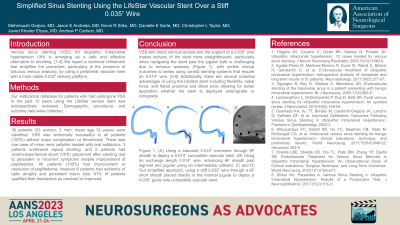Safety and Effectiveness of Venous Sinus Stenting with a Venous Stent over 0.035-inch Wire
Friday, April 21, 2023


Mehrnoush Gorjian, MD
Resident Physician
University of New Mexico Health Sciences Center
Albuquerque, New Mexico, United States
ePoster Presenter(s)
Introduction: Venous sinus stenting (VSS) for idiopathic intracranial hypertension (IIH) is an effective treatment option for selected patients. Technical challenges of VSS include navigating the stent past the jugular bulb or area of stenosis without prolapsing the supporting catheter into the heart. Large bore access systems increase the complexity of the procedure, may lead to less accurate placement, and still can prolapse in very stenotic anatomy. This report focuses on the technical safety and effectiveness of VSS with an over-the-wire system compatible with 0.035” guidewire via jugular access, and clinical improvement of symptoms including headache and papilledema on follow-up.
Methods: Retrospective review of our data identified 27 patients (24 women, 3 men, mean age 31.5 years, age range 11–50 years) who had undergone VSS procedures in the past 10 years. Indications for treatment included a clinical diagnosis of IIH with papilledema and evidence of functional venous stenosis on manometry. The procedure included 3 steps; an angiogram via radial or femoral artery to confirm the presence of stenosis and dominant outflow, a venogram via femoral vein for manometry, and stent deployment via brachial or internal jugular vein using Lifestar venous stent (Bard PV: Tempe, AZ) over a 0.035” wire following by manometry.
Results: VSS was technically successful in all patients (100%) without complication. Mean clinical follow-up was 4.5 months. Nineteen patients (70%) qualified their headaches as improved after VSS. Of 25 patients who underwent follow-up ophthalmological exam, all (100%) demonstrated improvement of papilledema.
Conclusion : VSS via cervical or brachial access and the support of a 0.035” wire makes delivery of the device simpler. Additionally, there are several potential advantages of using the venous specific stent over carotid stents, that use a 0.014” wire, including flexibility, radial force, and flared proximal and distal ends. Clinical efficacy appears to be similar to the published data.
Methods: Retrospective review of our data identified 27 patients (24 women, 3 men, mean age 31.5 years, age range 11–50 years) who had undergone VSS procedures in the past 10 years. Indications for treatment included a clinical diagnosis of IIH with papilledema and evidence of functional venous stenosis on manometry. The procedure included 3 steps; an angiogram via radial or femoral artery to confirm the presence of stenosis and dominant outflow, a venogram via femoral vein for manometry, and stent deployment via brachial or internal jugular vein using Lifestar venous stent (Bard PV: Tempe, AZ) over a 0.035” wire following by manometry.
Results: VSS was technically successful in all patients (100%) without complication. Mean clinical follow-up was 4.5 months. Nineteen patients (70%) qualified their headaches as improved after VSS. Of 25 patients who underwent follow-up ophthalmological exam, all (100%) demonstrated improvement of papilledema.
Conclusion : VSS via cervical or brachial access and the support of a 0.035” wire makes delivery of the device simpler. Additionally, there are several potential advantages of using the venous specific stent over carotid stents, that use a 0.014” wire, including flexibility, radial force, and flared proximal and distal ends. Clinical efficacy appears to be similar to the published data.
